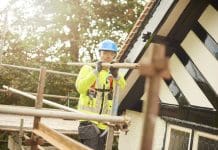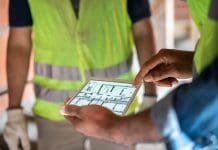Secured by Design is a national police project which aims to improve the physical security of a home. Edelweiss Arnold of the Secured by Design team explains how to comply with good standards of security and the Approved Document Q
During the 1980s, the United Kingdom saw a dramatic increase in domestic burglary offences. Security was often only considered after a crime, and there were examples of new housing estates where a set of just 12 keys could open the back door of every home on the estate.
Criminologists had also shown that criminals were taking advantage of residential layouts that failed to provide adequate natural surveillance and were highly permeable, where anonymity was absolute and escape routes plentiful. Identifying these risks and providing solutions became known as designing out crime.
Some police officers in South East England recognised that by combining the attributes of good standards of physical security with those of designing out crime, and presenting this in an easily understood format, would encourage architects and builders to address crime before the homes were built and at reduced cost. In 1989 they published their project under the title Secured by Design (SBD) and for the first time gave participating builders a police award for achieving good levels of security. The scheme became a national police project in 1992 and has been centrally managed since 1999.
Despite a reduction in property crimes since the mid-1990s, domestic burglary still costs the nation over £2.9 billion annually and, equally important is the social cost of property crime, which disproportionately affects the most vulnerable in communities. SBD works with those involved in the specification, design and build of new buildings or those undertaking property refurbishment to develop best practice in designing for crime prevention and to promote the use of security standards for a wide range of applications and products.
Independent research shows that the application of SBD principles has been proven to achieve a reduction of crime risk by up to 75%, by combining minimum standards of physical security and proven approaches to natural surveillance and defensible space.
Designing out Crime – the road to change
The introduction of a Building Regulation for security (Part Q) in 2015 builds on the planning policy goals established by the National Policy Planning Framework (NPPF), which calls for developers to demonstrate that key security attributes have been considered and applied within designs, ensuring a safe environment that is also fit for purpose.
In providing statutory targets for physical security, Part Q offers a mechanism for ensuring delivery to industry-acknowledged benchmarks, while realising the intention of the Sustainable and Secure Buildings Act of 2004 in ‘furthering the prevention or detection of crime’.
At the same time, the introduction of Part Q is designed to add clarity, following on from the ‘Housing Standards Review’ (HSR) launched by the government in October 2012, aimed at streamlining codes, standards, rules, regulations and guidance in order to reduce unnecessary costs and complexities in the house building process.
What does the accompanying Approved Document Q (Part Q) require – and where?
Part Q applies to all new homes, including those resulting from a change in use of existing buildings into homes. Specifically, the new regulations lay down minimum guidelines on attack resistance for doors, windows and roof-lights as most common points for intruder entry.
Doors:
Entrance doors including those that are easily accessible or provide access to the property including main, communal and garage doors.
Key requirements are:
• A secure doorset that is proven to resist physical attack, or a bespoke doorset incorporating construction features that are proven to reduce crime;
• Letter plates should not exceed a maximum size;
• Main entry doors must offer a means to see callers;
• Frames should be mechanically fixed to the structure of the building, and lightweight frames should incorporate a resilient layer.
Windows and roof-lights:
Similarly, other accessible points of entry should be secure, and frames should be mechanically fixed to the structure of the building.
Testing vs. Certification
Part Q calls for products to be manufactured to a sufficiently robust design and tested to acceptable security standards, which includes PAS 24, LPS 1175 and LPS 2081. These standards have been supported by Secured by Design (SBD) since 1999.
While SBD supports the introduction of the test requirement, for its own accreditation process it goes further and requires that products be fully certificated by independent third-party certification bodies.
Up to 50% of doors and windows that are tested will initially fail the security tests, with remedial work needed to resolve the issues. Certification involves initial and ongoing testing of the product, together with audits of both the production facility and the product. This approach ensures products are consistently produced to the required standard and will continue to meet the standard in use. SBD believes that this consistency is as important as the initial test and attributes the impressive decreases in burglary rates seen in SBD developments to this additional requirement.
The SBD accreditation scheme currently includes more than 500 companies, of which more than 4000 products have been awarded the ‘Police Preferred Specification’ status, covering thirty different categories of security products and offers an extensive source of reference to assist specifiers with product selection. Where accredited by the scheme, this information is also available online.
More than just products
Secured by Design also produces guidance documents that form the basis of the Development Award that is given to developments that meet the criteria outlined in the guides and so reduce the opportunity for crime.
This process is administered by designing out crime officers within the police forces around the country.
SBD National Building Approval
SBD has recently launched a new National Building Approval scheme to assist developers to meet both the requirements of the new Building Regulation and achieve the police preferred security specification. The new scheme significantly streamlines the Secured by Design process and provides developers with the reassurance that their specification is going to be accepted by both Building Control Bodies and police SBD Designing Out Crime Officers alike. The scheme has been accepted by the NHBC, LABC and the BCA. The chair of the Building Control Alliance, Kevin Dawson, said:
“The Building Control Alliance welcomes the introduction of Secured by Design National Building Approval and acknowledges the award as one way of demonstrating compliance with Part Q of the Building Regulations (England).” ■
. . . . . . . . . . . . . . . . . . . . . . . . . . . . . . . . . . . . . . . . . . . . . . .
Edelweiss Arnold
Marketing Manager
Police Crime Prevention Initiatives Ltd
t/a Secured by Design













